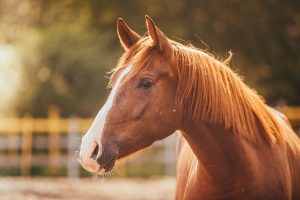 Horsemen recognize the importance of good-quality forage for horses and ponies. As such, horse owners are becoming savvier in choosing the best hay for their horses, especially when those horses are affected by metabolic conditions.
Horsemen recognize the importance of good-quality forage for horses and ponies. As such, horse owners are becoming savvier in choosing the best hay for their horses, especially when those horses are affected by metabolic conditions.
In order to gauge how much sugar or starch a hay contains, it must be submitted to a laboratory for analysis. In some instances, hay growers or brokers will have hay analyzed prior to offering it for sale. By reviewing these reports, horse owners have an idea if the hay is appropriate for their horses as a result (assuming the sellers have the starch and sugar analyzed).
The most common sugar and starch measurements available from a laboratory are water-soluble carbohydrates, ethanol-soluble carbohydrates, and starch.
- Water-soluble carbohydrates (WSC) are extracted from the sample with water. WSC include simple sugars, short-chain polysaccharides, and fructans.
– Simple sugars are digested in the small intestine, and their absorption significantly affects glycemic response.
– Fructans, on the other hand, are fermented in the large intestine. Their absorption has a less significant response on glycemic response but can affect the pH of the hindgut. In some horses, overconsumption of fructans is thought to have a role in the onset of laminitis. - Ethanol-soluble carbohydrates (ESC) is a subclass of WSC and measures only simple sugars and short-chain polysaccharides. Because of this, the amount of fructan can be estimated by subtracting ESC from WSC.
- Starch is a complex polysaccharide carbohydrate that is preferentially digested in the small intestine. When large amounts of feed are offered at one time, some undigested starch flows to the hindgut, where it is fermented.
– Fermentation of starch can lead to production of lactic acid, which can disrupt the carefully balanced microbial population of the hindgut.
How can a horse owner determine the level of nonstructural carbohydrates (NSC) in forage from this information?
“Traditionally, NSC can be calculated by adding WSC and starch,” said Kathleen Crandell, Ph.D., a nutritionist with Kentucky Equine Research. “NSC would include all of the monosaccharides and disaccharides as well as all polysaccharides, such as fructan, and starch.
“Occasionally, NSC is calculated adding ESC and starch, especially when dealing with concentrate feeds. Because of this, the fructan content is expected to be very low. In fact, grasses are more likely to form higher amounts of fructans than grains.
“However, when looking at NSC in forages, it is best to use WSC and starch for the calculation because of the negative effects both fructans and starch can have in the hindgut of sensitive horses.”
When faced with a metabolic horse, hay selection is critical. Of particular import is NSC content.
“For forages, I like to make sure the forage is under 12% NSC. Some nutritionists might go as low as 10%, but I feel there is little difference between 10 and 12% because forages have slow consumption rates. When horses eat a feedstuff over time, not as much sugar enters the bloodstream in one fell swoop,” said Crandell.
Though no hay can be reliably classified as low-NSC without being tested, some tend to be more appropriate for metabolic horses, according to Crandell.
“In my experience, warm-season grasses like coastal Bermudagrass and teff tend to be lower in NSC than cool-season perennial grasses, such as timothy and orchardgrass. One cool-season perennial in particular, ryegrass, can be very high in NSC and should be avoided for use in horses with any hint of metabolic issues. Believe it or not, legumes like alfalfa are usually lower in NSC than many grass hays.”
Stage of maturity can also influence NSC content, Crandell noted:
“Of course, there are always exceptions, but generally the more mature the grass, the lower the NSC or at least the lower the calories. Further, the more mature hays tend to be stemmier and require more chewing, resulting in slower consumption rates.”
Other factors may affect NSC levels, such as time of day the hay was cut (morning vs. evening), how quickly the hay was harvested out of the field, and whether it was rained on. If the hay spends more days drying before baling, NSC tends to be lower.
Horse owners often work with equine nutritionists to formulate rations. Having a hay analysis in hand allows the nutritionist to fine-tune the diet in a way that is impossible without.
When a hay analysis is not available, nutritionists must rely on average hay values. According to Crandell, that can differ considerably from the actual hay being fed.
“I am overjoyed when a horse owner has a hay analysis,” said Crandell. “If I have a forage analysis, then I can really nail down the nutrient levels in the diet.
“Imagine baking a cake by estimating the ingredients and their amounts versus using an exact recipe. Chances are, the cake will turn out satisfactory with estimated amounts, but the exact recipe will likely yield superior results.”
Horses on all-forage diets require vitamin and mineral supplementation for optimal nutrition. Choose a high-quality supplement formulated by a reputable manufacturer.
Visit J & J Hay Farms for more information.
